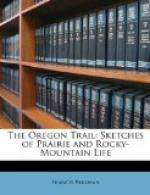A day passed, and Indians began rapidly to come in. Parties of two or three or more would ride up and silently seat themselves on the grass. The fourth day came at last, when about noon horsemen suddenly appeared into view on the summit of the neighboring ridge. They descended, and behind them followed a wild procession, hurrying in haste and disorder down the hill and over the plain below; horses, mules, and dogs, heavily burdened travaux, mounted warriors, squaws walking amid the throng, and a host of children. For a full half-hour they continued to pour down; and keeping directly to the bend of the stream, within a furlong of us, they soon assembled there, a dark and confused throng, until, as if by magic, 150 tall lodges sprung up. On a sudden the lonely plain was transformed into the site of a miniature city. Countless horses were soon grazing over the meadows around us, and the whole prairie was animated by restless figures careening on horseback, or sedately stalking in their long white robes. The Whirlwind was come at last! One question yet remained to be answered: “Will he go to the war, in order that we, with so respectable an escort, may pass over to the somewhat perilous rendezvous at La Bonte’s Camp?”
Still this remained in doubt. Characteristic indecision perplexed their councils. Indians cannot act in large bodies. Though their object be of the highest importance, they cannot combine to attain it by a series of connected efforts. King Philip, Pontiac, and Tecumseh all felt this to their cost. The Ogallalla once had a war chief who could control them; but he was dead, and now they were left to the sway of their own unsteady impulses.
This Indian village and its inhabitants will hold a prominent place in the rest of the narrative, and perhaps it may not be amiss to glance for an instant at the savage people of which they form a part. The Dakota (I prefer this national designation to the unmeaning French name, Sioux) range over a vast territory, from the river St. Peter’s to the Rocky Mountains themselves. They are divided into several independent bands, united under no central government, and acknowledge no common head. The same language, usages, and superstitions form the sole bond between them. They do not unite even in their wars. The bands of the east fight the Ojibwas on the Upper Lakes; those of the west make incessant war upon the Snake Indians in the Rocky Mountains. As the whole people is divided into bands, so each band is divided into villages. Each village has a chief, who is honored and obeyed only so far as his personal qualities may command respect and fear. Sometimes he is a mere nominal chief; sometimes his authority is little short of absolute, and his fame and influence reach even beyond his own village; so that the whole band to which he belongs is ready to acknowledge him as their head. This was, a few years since, the case with the Ogallalla. Courage, address, and enterprise may raise any warrior to the




